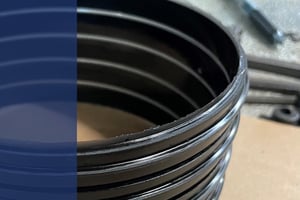What is Centrifugal Molding?
Centrifugal molding, also known as centrifugal casting or spin casting, is a cast molding process used to produce cylindrical-shaped objects with a hollow center. It involves rotating a mold at high speeds while a liquid material is poured into it. The centrifugal force generated by the rotation spreads the liquid material evenly along the mold cavity, creating a casting with high densities and minimal defects.
To learn more about centrifugal molding and how it may be beneficial to your product design, continue reading below:

How Does Centrifugal Molding Work?
Centrifugal molding utilizes rotation to achieve a uniform distribution of liquid material, like thermoset polyurethanes, within a mold. There are different variations of centrifugal casting, including horizontal and vertical orientations, as well as centrifugal shells. The process begins with preheating the mold, which is then mounted onto a spinning machine. The liquid material is poured into the rotating mold, allowing the centrifugal force to evenly spread it. As the material cools and solidifies, the mold is opened, and the casted part is extracted. This method ensures consistent distribution and produces high-quality castings, making it ideal for manufacturing cylindrical components in various industries.
The Benefits of Centrifugal Molding
The centrifugal casting process has several advantages. For starters, it enables the production of cylindrical components made from thermoset polyurethanes to achieve superior physical properties, such as abrasion resistance, conductivity, and compression set to name a few. The centrifugal force helps to eliminate porosity and other imperfections, resulting in high-quality results. Additionally, the process allows for the production of hollow objects with a variety of geometries.
Here are 5 additional benefits of centrifugal molding:
| Enhanced Material Utilization | Centrifugal molding allows for efficient material usage. The centrifugal force helps in the uniform distribution of the liquid material along the mold cavity, minimizing material waste and achieving higher yield rates. |
| Cost Savings | The centrifugal casting process can be cost-effective compared to other casting methods. It requires less machining and secondary operations due to the superior surface finish and dimensional accuracy of the products produced. |
| Design Flexibility | Centrifugal molding offers design flexibility, enabling the production of complex and intricate shapes. The rotational motion of the mold allows for the creation of components with varying wall thicknesses, contoured surfaces, and integrated features. |
| Reduced Post-Casting Processes | The high-quality castings produced through centrifugal molding often require minimal post-casting processing. This results in shorter production cycles, lower labor costs, and improved overall efficiency. |
| Improved Mechanical Properties | The unique casting conditions in centrifugal molding, such as the controlled solidification process and reduced segregation, contribute to enhanced mechanical properties of the castings. This includes improved tensile strength, ductility, and resistance to fatigue and cracking. |
Centrifugal Molding in Product Design
 Centrifugal molding offers valuable opportunities in product design due to its unique capabilities. The process enables the production of complex and intricately shaped components with varying wall thicknesses, contoured surfaces, and integrated features. This design flexibility allows engineers and designers to explore innovative designs that may not be achievable with other casting methods. Additionally, centrifugal molding can be used to create hollow objects with a range of diameters and lengths, offering lightweight solutions without compromising structural integrity. The high-quality castings produced through centrifugal molding, with their excellent physical properties and dimensional accuracy, contribute to the overall performance and reliability of the final product. By leveraging the advantages of centrifugal molding, product designers can optimize the functionality, aesthetics, and cost-effectiveness of their designs, opening up new possibilities for a wide range of industries, including automotive, aerospace, and paper & media handling.
Centrifugal molding offers valuable opportunities in product design due to its unique capabilities. The process enables the production of complex and intricately shaped components with varying wall thicknesses, contoured surfaces, and integrated features. This design flexibility allows engineers and designers to explore innovative designs that may not be achievable with other casting methods. Additionally, centrifugal molding can be used to create hollow objects with a range of diameters and lengths, offering lightweight solutions without compromising structural integrity. The high-quality castings produced through centrifugal molding, with their excellent physical properties and dimensional accuracy, contribute to the overall performance and reliability of the final product. By leveraging the advantages of centrifugal molding, product designers can optimize the functionality, aesthetics, and cost-effectiveness of their designs, opening up new possibilities for a wide range of industries, including automotive, aerospace, and paper & media handling.
If you believe centrifugal molding may be the right process for your product design, complete our design tool, here, or download our material data sheets below to begin your custom product or component!



